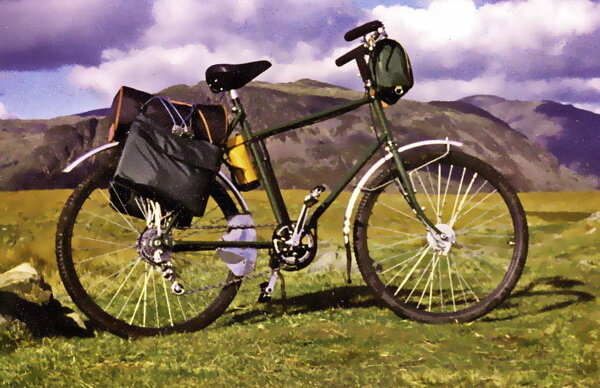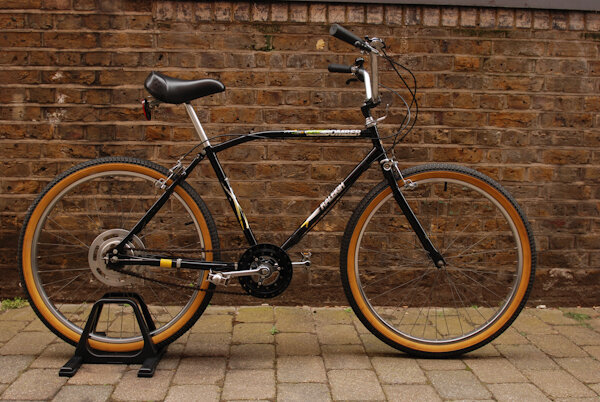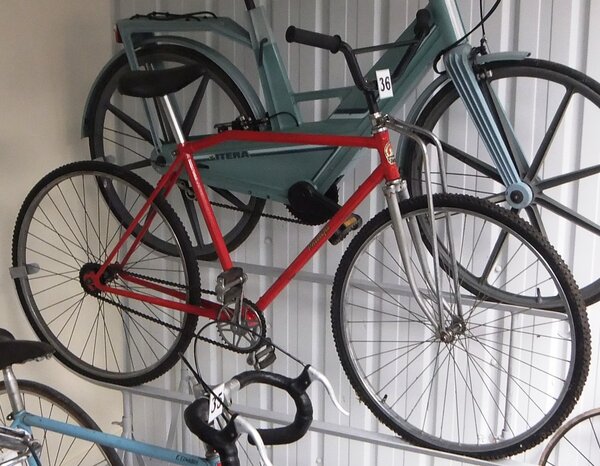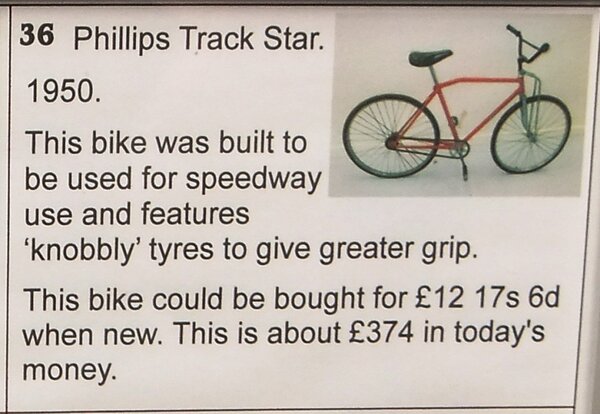You are using an out of date browser. It may not display this or other websites correctly.
You should upgrade or use an alternative browser.
You should upgrade or use an alternative browser.
Vindec-the british missing link?
- Thread starter justbackdated
- Start date
- Feedback
- View
Here's something I knocked together that links the history of "Tracker bikes" with the development of Geoff Apps bike designs from 1977 onwards. And how Apps discovery of Fat Finnish snow tyres allowed for the independent development of distinctive British fat tyre bikes. Unaware of concurrent US developments that relied upon the availability of fat 26" klunker tyres. And the legacy of the larger diameter of the tyres exported by Apps that went on to inspire some US mountain bike designers to create the 29er.
So somewhere deep inside every 29er must be a few "Tracker bike" genes!
The brief history & legacy of British mountain bikes
BACKGROUND
For over 100 years Britain has had a tradition of off-road cycling for leisure and adventure. Despite this the only specialist bicycles that developed were those with small wheels intended for children. British bicycle manufacturers considered the adult off-road cycling tradition as a minority activity not realising that grown up BMX and Grifter riders would still want the excitement and challenge of riding off-road.
TRACKER BIKES
In the 1960s and ‘70s, because manufacturers did not make off-road bikes for older children, teenagers made their own from by adding cow-horn handlebars and knobbly tyres. These were known as tracker bikes and it was from this ‘skip bike’ tradition that Geoff Apps began. In the late 1960s/early 1970s, he moved on to competitive motor bike trials riding, but he still dreamed of building his own specialist off-road bicycle.
In 1977, Apps entered an off-road bicycle design into a ‘Bike of the Future’ competition.
In 1978, the judges rejected such designs as being no more than pedal powered motorcycles, but Apps was not deterred and set about building his design. He searched the BMX, motorbike and cycling worlds for suitable parts and completed his first Range-Rider bike in 1979. Over the next three years he built a series of seven experimental prototypes whilst trying to sell his designs to a sceptical UK cycling industry where new bikes were usually designed in house. Frustrated by having his designs turned down, in 1982 he teamed up with frame-builder Jeremy Torr, and started making his latest design the ‘Aventura’ under the Cleland Cycles brand name. Cleland was Europe’s first mountain bike manufacturer and made bikes until mid 1984 when production stopped when, for an unknown reason, a supplier refused to provide essential parts.
Apps’ inspired British style mountain bikes were also made by English Cycles and Highpath Engineering until the 1990s.
THE BEST WHEEL SIZE FOR THE EARLY MOUNTAINBIKES
From 1980 to 1984 Apps supplied hundreds of 700x47c and 650x54b Finnish Hakkapeliitta tyres he used to US mountain bike pioneers Gary Fisher and Charlie Kelly who built bikes to fit them. Though they preferred these large diameter tyres, the high import taxes and erratic supplies from Finland, US mountain bikes developed with smaller 26” wheels.
THE 29ER LEGACY
In 1987, a Marin frame-builder Bruce Gordon obtained some unused 700c Hakkapelita tyres and made some bikes to fit them. He was so impressed with the ride quality that he had copies of the tyres made so that he and other frame-builders could continue making 700c mountain bikes. In 1998 one of these builders, Wes Williams persuaded Gary Fisher to back the development of a new 700c mountain bike tyre, the WTB’ Nanoraptor. Fisher then developed bikes for these big tyres and that eventually became known as 29ers because they had an overall diameter close to 29 inches.
650B / 27.5” REVIVAL
Us bike designer Kirk Pacenti, thought that bigger diameter wheeled mountain bikes were a good idea but that 700c was too big for the average rider. So in 2007 revived the 670b or 27.5” wheel-size. The same size that Apps chose for his Cleland production bikes back in 1982.
HISTORICAL OVERVIEW
The development of US mountain bikes became a decisive nail in the coffin of the British cycling manufacturers. Raleigh, who had lost money in the sudden collapse of BMX sales in the early 1980s, thought that mountain bikes where likely to be a short lived fad and so decided not to make them.
As a result from 1983-85, far east made mountain bikes flooded into Britain. These imported bikes also included new UK owned brands like Ridgeback and Muddy Fox. And by the time Raleigh realised there mistake and started producing their own mountain bikes in 1985, they had missed the opportunity to be the market leaders.
In the 1970s British manufacturers produced most of the bicycles in the world. Had they taken Geoff Apps lead and got into mountain bike production at the same time as the Americans, then they would have been in a better position to fight off the competition.
So somewhere deep inside every 29er must be a few "Tracker bike" genes!
The brief history & legacy of British mountain bikes
BACKGROUND
For over 100 years Britain has had a tradition of off-road cycling for leisure and adventure. Despite this the only specialist bicycles that developed were those with small wheels intended for children. British bicycle manufacturers considered the adult off-road cycling tradition as a minority activity not realising that grown up BMX and Grifter riders would still want the excitement and challenge of riding off-road.
TRACKER BIKES
In the 1960s and ‘70s, because manufacturers did not make off-road bikes for older children, teenagers made their own from by adding cow-horn handlebars and knobbly tyres. These were known as tracker bikes and it was from this ‘skip bike’ tradition that Geoff Apps began. In the late 1960s/early 1970s, he moved on to competitive motor bike trials riding, but he still dreamed of building his own specialist off-road bicycle.
In 1977, Apps entered an off-road bicycle design into a ‘Bike of the Future’ competition.
In 1978, the judges rejected such designs as being no more than pedal powered motorcycles, but Apps was not deterred and set about building his design. He searched the BMX, motorbike and cycling worlds for suitable parts and completed his first Range-Rider bike in 1979. Over the next three years he built a series of seven experimental prototypes whilst trying to sell his designs to a sceptical UK cycling industry where new bikes were usually designed in house. Frustrated by having his designs turned down, in 1982 he teamed up with frame-builder Jeremy Torr, and started making his latest design the ‘Aventura’ under the Cleland Cycles brand name. Cleland was Europe’s first mountain bike manufacturer and made bikes until mid 1984 when production stopped when, for an unknown reason, a supplier refused to provide essential parts.
Apps’ inspired British style mountain bikes were also made by English Cycles and Highpath Engineering until the 1990s.
THE BEST WHEEL SIZE FOR THE EARLY MOUNTAINBIKES
From 1980 to 1984 Apps supplied hundreds of 700x47c and 650x54b Finnish Hakkapeliitta tyres he used to US mountain bike pioneers Gary Fisher and Charlie Kelly who built bikes to fit them. Though they preferred these large diameter tyres, the high import taxes and erratic supplies from Finland, US mountain bikes developed with smaller 26” wheels.
THE 29ER LEGACY
In 1987, a Marin frame-builder Bruce Gordon obtained some unused 700c Hakkapelita tyres and made some bikes to fit them. He was so impressed with the ride quality that he had copies of the tyres made so that he and other frame-builders could continue making 700c mountain bikes. In 1998 one of these builders, Wes Williams persuaded Gary Fisher to back the development of a new 700c mountain bike tyre, the WTB’ Nanoraptor. Fisher then developed bikes for these big tyres and that eventually became known as 29ers because they had an overall diameter close to 29 inches.
650B / 27.5” REVIVAL
Us bike designer Kirk Pacenti, thought that bigger diameter wheeled mountain bikes were a good idea but that 700c was too big for the average rider. So in 2007 revived the 670b or 27.5” wheel-size. The same size that Apps chose for his Cleland production bikes back in 1982.
HISTORICAL OVERVIEW
The development of US mountain bikes became a decisive nail in the coffin of the British cycling manufacturers. Raleigh, who had lost money in the sudden collapse of BMX sales in the early 1980s, thought that mountain bikes where likely to be a short lived fad and so decided not to make them.
As a result from 1983-85, far east made mountain bikes flooded into Britain. These imported bikes also included new UK owned brands like Ridgeback and Muddy Fox. And by the time Raleigh realised there mistake and started producing their own mountain bikes in 1985, they had missed the opportunity to be the market leaders.
In the 1970s British manufacturers produced most of the bicycles in the world. Had they taken Geoff Apps lead and got into mountain bike production at the same time as the Americans, then they would have been in a better position to fight off the competition.
- Feedback
- View
You'll have that Purple bloke ranting again!
That Vindec is just a copy of the Raleigh Bomber which in itself is an old 'roadster' built for the Nigerian market.


Personally I dont link these style bikes to the early history of MTB UK/ US etc - they were just bikes with motorbike bars and the Bomber was for marketing as already stated, they thought the MTB was a short lived fad.
I did mess around with a mates bike by fitting the grifter bars to a 3 spd roadster type bike but that would have been 1985 - got the gears to work and everything - not bad for an 11 year old.
I think we all built weird and wonderful bikes at some point or other before the MTB was born propper
That Vindec is just a copy of the Raleigh Bomber which in itself is an old 'roadster' built for the Nigerian market.

Personally I dont link these style bikes to the early history of MTB UK/ US etc - they were just bikes with motorbike bars and the Bomber was for marketing as already stated, they thought the MTB was a short lived fad.
I did mess around with a mates bike by fitting the grifter bars to a 3 spd roadster type bike but that would have been 1985 - got the gears to work and everything - not bad for an 11 year old.
I think we all built weird and wonderful bikes at some point or other before the MTB was born propper
- Feedback
- View
The Raleigh Bomber was first introduced in 1981 so the Vindec' Trecker model predates it by some margin though I don't know the date that it first appeared. It was something that was very rare, a bicycle that appears to be inspired by the "Tracker" skip/street bikes. Bikes that young people who couldn't afford new bikes cobbled together for themselves from salvaged parts.legrandefromage":2tzr8m1u said:That Vindec is just a copy of the Raleigh Bomber which in itself is an old 'roadster' built for the Nigerian market.
Raleigh would never have made these bikes because they only produced models that were conceived by their in house design team. Apart from the Moulton that is, where they undermined sales to the point when Alex Moulton was forced to sell the company to them.
As a child in Aston Clinton, Geoff Apps started out building his own "Tracker" style bikes from parts abandoned in ditches etc. He then moved on to riding Trials motorbikes but was drawn back to cycling when he entered his ideal off road bicycle design into a national bicycle design competition in 1977.legrandefromage":2tzr8m1u said:Personally I dont link these style bikes to the early history of MTB UK/ US etc - they were just bikes with motorbike bars...
It was his experience of trials motorbikes combined with the return to tinkering with bikes that marked him out from the thousands of other "Tracker" bike enthusiasts that simply grew out of modifying bikes and cycling off road. He says that by cycling off road as an adult, generally people viewed him as being eccentric.
I guess that it is was partly this that the MTB tapped into. MTBs meant that we could carry on building 'weird and wonderful bikes' into adult hood.legrandefromage":2tzr8m1u said:I think we all built weird and wonderful bikes at some point or other before the MTB was born propper
- Feedback
- View
That vindec isnt as 'old' as it looks - you know yourself that cotter pin cranks were used well into the 1980's and beyond.
- Feedback
- View
Re:
Most of the anecdotal online chat room info relating to the Vindec Trekker date it between 1979 and the mid 80s. I also found one ebay seller who says his bike is a 1980 model.
Also this account from a halfords Trackstar owner:
"I had a remarkably similar accident WAAAAAAAAY back in 1981!
I hit a rock on my Halfords Trackstar and down I went, impaling my face on the end of the bar, forcing it into my eyebrow. I lost conciousness at this point (thankfully), but my friends managed to prise me off the bike and walk me the short distance home.
28 years later and I still bear a rather fetching circular scar that runs through my left eyebrow. The scary thing is that if it had been 15mm lower it'd probably have killed me, or at the very least taken out an eye.
I've never NOT had a bike, and even after the accident I couldn't wait to get back on two wheels, much to the disappointment of my mother who wanted to get rid of my bike at the earliest opportunity.
Thankfully she didn't.
Well done mum, x."
http://www.bikeradar.com/forums/viewtop ... p=15162416
However the term "Trackstar" suggests that the inspiration for these bikes may have come not from "Tracker" bikes, as has been suggested before, but from cycle speedway.
Most of the anecdotal online chat room info relating to the Vindec Trekker date it between 1979 and the mid 80s. I also found one ebay seller who says his bike is a 1980 model.
Also this account from a halfords Trackstar owner:
"I had a remarkably similar accident WAAAAAAAAY back in 1981!
I hit a rock on my Halfords Trackstar and down I went, impaling my face on the end of the bar, forcing it into my eyebrow. I lost conciousness at this point (thankfully), but my friends managed to prise me off the bike and walk me the short distance home.
28 years later and I still bear a rather fetching circular scar that runs through my left eyebrow. The scary thing is that if it had been 15mm lower it'd probably have killed me, or at the very least taken out an eye.
I've never NOT had a bike, and even after the accident I couldn't wait to get back on two wheels, much to the disappointment of my mother who wanted to get rid of my bike at the earliest opportunity.
Thankfully she didn't.
Well done mum, x."
http://www.bikeradar.com/forums/viewtop ... p=15162416
However the term "Trackstar" suggests that the inspiration for these bikes may have come not from "Tracker" bikes, as has been suggested before, but from cycle speedway.
- Feedback
- View
I'm wary of posting anymore in case the purple amphibian denounces me as some sort of pariah. Anyway the literature I have from that era do suggest cycle speedway was a big influence on late 70's bodge bikes...
- Feedback
- View
Re:
Here is an interesting letter published on the CTC letters page in 2011:
MTB ANTECEDENTS
"Like many pre-MTB or ATB cyclists of
my generation, I remember making my
own ‘tracker’ type bike for riding in the
local forestry and off-road tracks in the
area. It consisted of an old ’70s racer
from the tip fitted with cow-horn type
handlebars and ‘knobblies’ from the
local bike shop.
Around 1980, however, I remember
being given a new Vindec Trekker bicycle
by my parents, which was an excellent
bike. It had a three-speed hub, fork
strengtheners, a sloping frame, wide
cow-horn bars and was very reminiscent
of the Geoff Apps bike featured in last
month’s magazine. Could this have been
Apps designed? It certainly hooked me
on off-road riding.
Steve Knowles"
http://www.ctc.org.uk/file/member/201011018.pdf
If Geoff Apps did have a hand in designing the Vindec Trekker he has kept it very quiet for all these years.
Whilst its not impossible that Vindec knew of Geoff Apps' early designs it is unlikely.
Apps however, had been riding "Tracker" bikes for years and would have also known about "Cycle Speedway" bikes.
So it's pretty likely that both Vindec and Apps were in some way influenced by the earlier traditions.
Here is an interesting letter published on the CTC letters page in 2011:
MTB ANTECEDENTS
"Like many pre-MTB or ATB cyclists of
my generation, I remember making my
own ‘tracker’ type bike for riding in the
local forestry and off-road tracks in the
area. It consisted of an old ’70s racer
from the tip fitted with cow-horn type
handlebars and ‘knobblies’ from the
local bike shop.
Around 1980, however, I remember
being given a new Vindec Trekker bicycle
by my parents, which was an excellent
bike. It had a three-speed hub, fork
strengtheners, a sloping frame, wide
cow-horn bars and was very reminiscent
of the Geoff Apps bike featured in last
month’s magazine. Could this have been
Apps designed? It certainly hooked me
on off-road riding.
Steve Knowles"
http://www.ctc.org.uk/file/member/201011018.pdf
If Geoff Apps did have a hand in designing the Vindec Trekker he has kept it very quiet for all these years.
Whilst its not impossible that Vindec knew of Geoff Apps' early designs it is unlikely.
Apps however, had been riding "Tracker" bikes for years and would have also known about "Cycle Speedway" bikes.
So it's pretty likely that both Vindec and Apps were in some way influenced by the earlier traditions.
Attachments
- Feedback
- View
Re:
Bingo
It helps if you search in the correct decade. Not 1980s but the 1950s.
This is an earlier variant made by Phillips Cycles in 1950. Phillips at one time where the second biggest bicycle manufacturer in the world, after Raleigh.
This Phillips' Track Star model is definitely a "Cycle" Speedway bike, and the Later Vindec appears to be a 'street legal' variant.
Interestingly, Phillips were taken over by Raleigh in 1980. A year later a new Raleigh model appeared that had a similar frame shape. It was called the Raleigh Bomber :shock:
Bingo
It helps if you search in the correct decade. Not 1980s but the 1950s.
This is an earlier variant made by Phillips Cycles in 1950. Phillips at one time where the second biggest bicycle manufacturer in the world, after Raleigh.
This Phillips' Track Star model is definitely a "Cycle" Speedway bike, and the Later Vindec appears to be a 'street legal' variant.
Interestingly, Phillips were taken over by Raleigh in 1980. A year later a new Raleigh model appeared that had a similar frame shape. It was called the Raleigh Bomber :shock:
Attachments
Similar threads
Latest posts
-
-
-
-
For Sale 1988 Ridgeback 603 22” Frame. Exceptional condition for age.
- Latest: Guinessisgoodforyou
-



